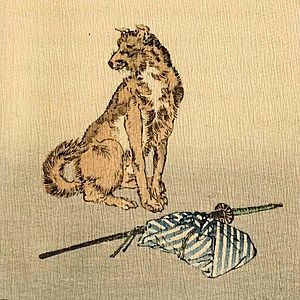Shippeitaro facts for kids
Shippeitaro or Shippei Taro (しっぺい太郎, 竹篦太郎, 悉平太郎, 執柄太郎) is the name of a brave helper dog in a famous Japanese fairy tale. This story is also known by the German spelling Schippeitaro. It's a tale about courage and outsmarting evil spirits.
The story of Shippeitaro has been told in many ways. One popular version, found in books like Andrew Lang's Violet Fairy Book (1901) and Mrs. T. H. James's "Schippeitaro" (1888), tells of mountain spirits who act like cats. These spirits demand a young village girl as a sacrifice every year. A young warrior hears the spirits talking about their weakness: someone named "Shippeitaro." He discovers Shippeitaro is a strong dog. The warrior then cleverly puts the dog in the place of the girl inside the sacrifice container. When the spirits arrive, the warrior and Shippeitaro attack and defeat them.
In most other versions of the tale, the evil spirits are monkeys, not cats. Japanese experts who study folktales call this type of story "Destroying the Monkey Demon."
The brave dog in the story might have slightly different names, like Suppeitarō or Suppetarō. Sometimes, the dog is called "Hayatarō from Kōzenji temple." In some versions, the dog doesn't even have a name!
Old Japanese story collections from the Middle Ages, like Konjaku Monogatarishū and Uji Shūi Monogatari, have similar tales. These old stories might be where the Shippeitaro folktale first came from.
Contents
How the Story Is Told
The version of "Schippeitaro" in Andrew Lang's The Violet Fairy Book (1901) came from a German collection of Japanese stories.
Mrs. T. H. James's story of "Schippeitaro" (1888) was part of a special series of "Japanese Fairy Tale" books. These books were printed on unique "crepe-paper." Mrs. James's story is very similar to the one in Lang's book.
The Story of the Warrior and the Dog
Here's a summary of the story from the Lang/Mrs. James versions:
A young warrior was traveling, looking for adventures. He stopped to rest in a shrine inside an enchanted forest. At midnight, he woke up to loud yowling sounds. He saw many cats dancing and shouting, "Don't tell Shippeitaro!"
The warrior continued his journey and soon found a village. He heard a girl crying and asking for help. The villagers told him that every year, they had to offer a young maiden to the spirit of the mountain. This year, it was the crying girl's turn. She was placed inside a cage that would be left at the shrine.
The warrior remembered the cats' words and asked about Shippeitaro. He learned that Shippeitaro was a strong dog belonging to a nearby prince's overseer. The warrior visited the overseer and convinced him to lend him the dog.
He went to the cage and secretly replaced the maiden with Shippeitaro. The cage was then taken to the shrine. When the cats arrived, a huge black cat opened the cage. Shippeitaro bravely jumped out and attacked the black cat, killing it. The warrior then joined in, helping Shippeitaro fight and defeat several other cats before the rest ran away.
In the morning, the warrior returned Shippeitaro to his owner. From that day on, the village held a big celebration every year to honor the brave warrior and Shippeitaro.
Different Versions of the Tale
The story where cats are the bad guys, like in the Lang/Mrs. James version, is actually quite rare. In most Shippeitaro tales, the evil spirits are monkeys or baboons.
For example, a version collected in Japan tells of a priest who defeated ogres. These ogres turned out to be dead monkeys. The priest used the dog Shippei Taro, found in a faraway city, to replace the girl in the chest.
There are many different versions of this story across Japan. The dog might not always have a name, or its name might be a bit different. Sometimes it's Shippeitarō, and sometimes it's Hayatarō or Heibōtarō. These names often depend on the region where the story is told. For instance, Shippeitarō is often heard near Shizuoka Prefecture, while Hayatarō is more common in Nagano Prefecture.
The evil spirits in these stories can also change. They might be monkeys, cats, rats, badgers, or even "raccoon dogs" (called mujina or tanuki in Japan).
Old Books with Shippeitaro
There's even an old printed book from the Edo Period (1603-1868) called Zōho Shippeitarō (1796). This "expanded version" of the story was written by Nansenshō Somahito and had pictures by a famous artist named Toyokuni. This book shows spirits like monkeys, foxes, kappa (water spirits), tanuki (raccoon dogs), hares, and wolves eating the human sacrifice. In the exciting final scene, Shippeitarō defeats wolves!
Story Type
In Japanese folklore studies, the "Shippeitarō" story belongs to a group of tales called "Destroying the Monkey Demon." This group includes stories where a hero defeats an evil monkey spirit, even if a dog isn't involved.
Because the story ends with the heroes stopping the practice of human sacrifice, it's a bit like the legend of Saint George and the Dragon. It also has some similarities to the Japanese myth of Susanoo saving Kushinadahime from the giant serpent Yamata no Orochi.
In a worldwide system for classifying folktales, the Shippeitaro story is known as "The Dragon Slayer" type.



